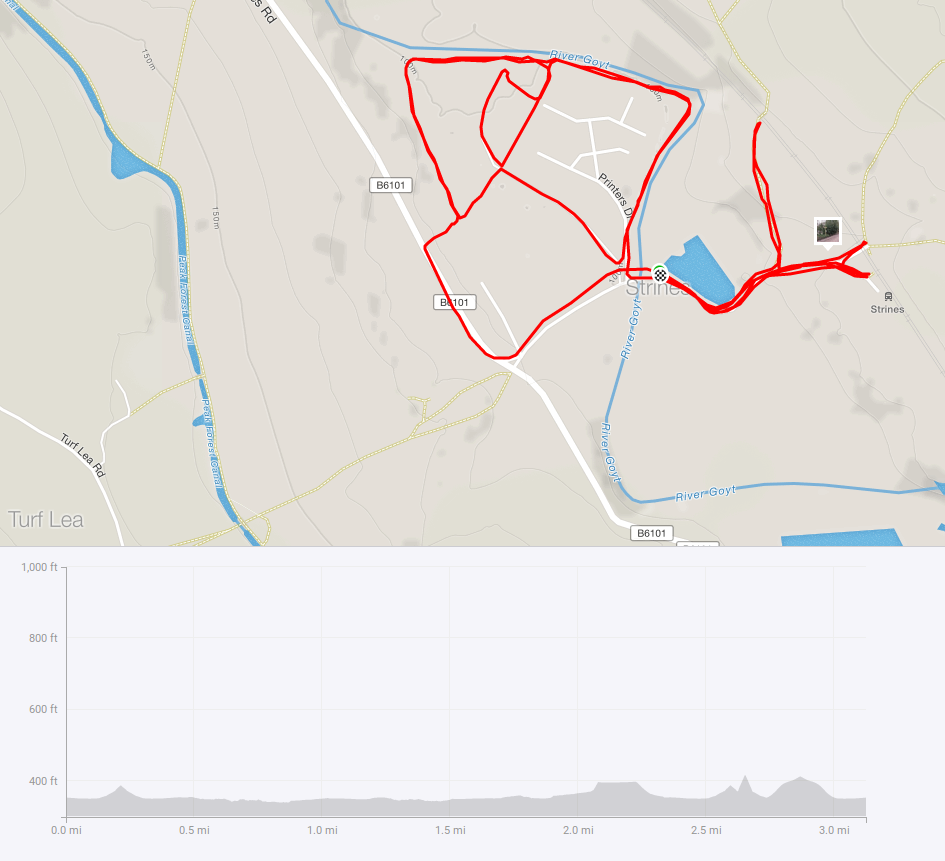It took me quite an effort to get up this morning. The effect of doing lots of running yesterday, having done a lot of running in the previous few days!
Today’s run
I spent the morning at work trying to fathom out where the energy for today’s run was going to come from. I decided that, at the very least, my trail shoes could have a trip out with me. I hoped that this would make sure I took the best running opportunity.
It came after my last job of the morning whilst up in Strines. I’ve done a couple of nice trail runs here recently, but today it was all about a steady recovery run. I’d aimed for just a mile (being the minimum recordable on Smashrun, which I’m using to record the challenge) but in the end it spun into a 5k.
Whilst running around I was still thinking about what I’d like to cover in today’s blog part of the challenge. In the end, I realised the answer had been staring at me from the word go.
Too much of a good thing?
It’s true to say that most runners like to run. And where there’s an opportunity, we’ll often capitalise on it. Running shoes packed to go on holiday. Keeping a pair of shoes in the car ‘just in case’.
We also like to measure our fitness and in particular, how much fitter we’re getting. We set goals to achieve; miles per week? Getting a PB? Running a marathon?. It’s one of the more popular questions that appears on the @UKRunChat twitter feed. There’s a wealth of experience out there so why not tap into it?!
One of the least appreciated aspects of training is REST / RECOVERY.
The body is a biological system within which we train our muscles to be stronger in order to further our running goals. So the aspect of train, train, train seems on the surface to be able to improve things. But it’s not quite that simple.
Training and overload
The training and overload principle in the first instance appears to follow the above. i.e. keep increasing the load and the muscles will get stronger. But if that was the case, adding a bit further every day ad infinitum and suddenly anyone who trained would be running superhuman distances. In practice, if you kept doing this, you would overtrain and likely become injured, burned out, ill.
The missing section is recovery.
What essentially needs to happen is this. Once the muscle has been exposed to a stress (say by running a little further/faster than it’s used to), the body needs to ‘address’ that stressing. This may be a matter of repairing muscle fibres as well as recovering the excess energy spent. Obviously the bigger the stress that has occurred, the more risk of damage to the system, which is why a period of rest after a heavy training session is needed.
In ‘recovering’ from a ‘mild’ stressing, the muscle begins to adapt so that it can withstand that level of stress next time around. This recovery and adaptation period is something specific to the individual and is generally ascertained by intrinsic analysis (how tired out you still are) as well as by looking at health indicators such as Heart Rate Variability (HRV). HRV is a measure which is correlated to the behaviour in the central nervous system which itself is impacted by stress. Understanding the HRV data can give a measurable figure on how recovered you are.
Adaptation and plateau
Once the recovery/adaption period is complete, further training in a similar vein will build on that fitness level. Too soon, recovery isn’t complete and performance will be lower. Leave it too long and the adaptation gradually returns back to where it started.
This also highlights that whilst doing a particular level of training for a period of time yields an improvement, after a while, the performance plateaus out. The big danger here is to keep pushing on the training, but instead of improved performance, the risk of failure/fatigue/injury increases.
So why is this relevant here?
You may be wondering why I have chosen to do a whistle-stop tour of overload training theory (extremely high level and whistle stop; there’s plenty of material to read out there).
Doing a #RED (Run Every Day) challenge places the body in a period of stress; normally one doesn’t do this. However with running each day, the opportunity for recovery is more difficult unless you specifically plan it. Assuming that you continue to run each day, it’s a matter of ensuring that after ‘heavy’ days e.g. post race or after a big training session, you factor in enough slower / shorter efforts so the muscles in the body have a chance to recover. Otherwise, the risk of injury or illness is increased. Although regular exercise is an excellent approach to good health, over-training can overwork the immune system.
So if you’re looking at doing such a challenge, don’t forget to look after yourself.



Be the first to comment on "Too much of a good thing? #REDBED Day 6"